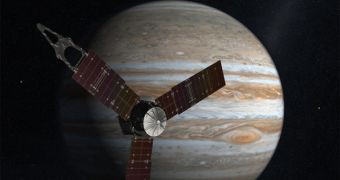A spacecraft that will launch to Jupiter later this year has arrived at a preparations facility in Florida. It was delivered to the Astrotech payload processing facility, in Titusville, by engineers at the Denver-based Lockheed Martin Space System, which is the main contractor NASA selected for the mission.
The probe, called Juno, is scheduled to carry out 33 orbits around the innermost of the four gas giants in our solar system. During these flights, astronomers hope to be able to clear up some of the most well-concealed mysteries Jupiter is still keeping.
Among the primary mission objectives, NASA experts listed finding out the more about the origins and structure of the planet. Planetary scientists are also interested in deciphering some of the most puzzling aspects of the Jovian atmosphere and magnetosphere.
Juno will be powered by solar panels, just like the Cassini orbiter around Saturn is. Unlike its Saturnine counterpart though, the new spacecraft is not scheduled to orbit its gas giant for a long time.
“The Juno spacecraft and the team have come a long way since this project was first conceived in 2003,” explains the principal investigator on the new mission, expert Scott Bolton.
“We're only a few months away from a mission of discovery that could very well rewrite the books on not only how Jupiter was born, but how our solar system came into being,” he goes on to say.
Bolton holds an appointment as a research scientist at the San Antonio, Texas-based Southwest Research Institute (SwRI). The mission is managed by the NASA Jet Propulsion Laboratory (JPL), in Pasadena, California.
The California Institute of Technology (Caltech), also in Pasadena, is managing JPL for the NASA Science Mission Directorate (SMD), at the space agency's Headquarters in Washington, DC.
Having arrived in Titusville, the new spacecraft will be left to rest for the weekend. On Monday, April 11, it will be unpacked from its shipping container, and put through its paces in a large number of validation and calibration tests.
Functional tests will also begin late next week, promptly followed by a series of mission readiness tests. Engineers in Florida have already prepared an updated flight software, and plan to upload it on Juno before the investigation begin.
According to the NASA flight manifest, the orbiter will lift off from Launch Complex 41 at the Cape Canaveral Air Force Station (CCAFS), in Florida. It will be carried into space by an Atlas V delivery system. The rocket is built by the United Launch Alliance.
Launch window opportunities open from August 5 through August 26. If NASA wants to launch the probe on August 5, then a launch window is opened between 8:39 am PDT (1639 GMT) and 9:39 am PDT (1739 GMT).

 14 DAY TRIAL //
14 DAY TRIAL //